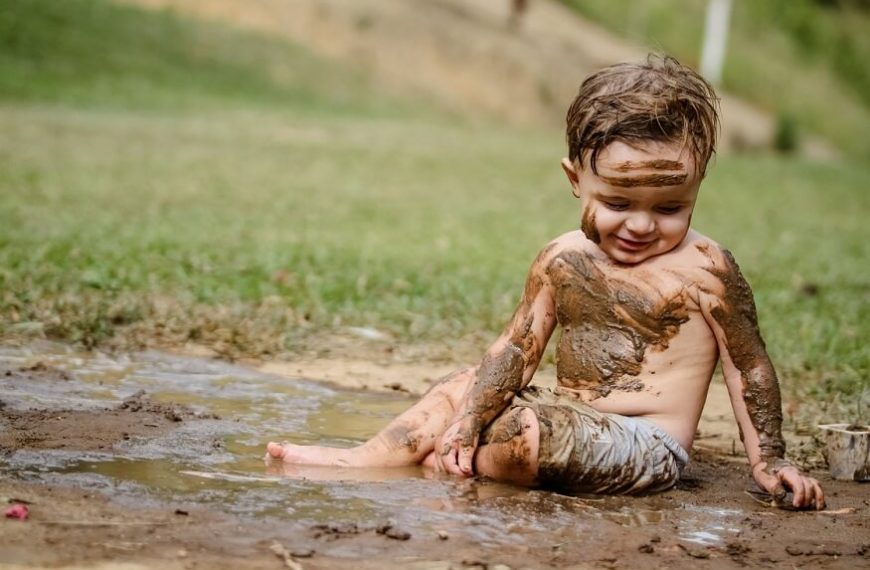Benefits of Mud Play for Children
Nobody enjoys seeing their children playing in the dirt. However, the majority of kids really like playing in the mud, sand, and dirt. They don’t care how many bacteria and germs are inside of them and like making messes. Let us reassure you that your kids will really benefit from playing in the mud before you start getting the shakes! We’re not joking. Read on to learn why letting your kids play in the mud is better for them than bad.
The image of kids playing in the dirt is very grounding in our technological and screen-dominated society. It is nothing short of endearing to see how happy and enthusiastic kids are when slogging through mud, making mud pies, or simply enjoying the damp, earthy sensation of their hands. But does this long-standing custom have any deeper meaning, or is it just for fun? In this blog, we’ll explore the world of mud play and all of its advantages for kids’ growth and well-being.
What Is Mud Play?
Any outdoor activity that incorporates mud, such as playing in a sandbox or sandcastle-building on the beach, is referred to as “mud play.” The main focus of mud play is having fun and being creative with mud, usually wet mud, which youngsters can mould, smash, and even attempt splashing. Mother Nature provides it to your kids in plenty, so you don’t have to spend a dollar on it.
Why Kids Playing in Mud is Important:
Can I go play in the mud, Mom? Many parents have been asked this question by their kids at some point or another. While some parents may immediately squirm at the idea of their children becoming mucky, there is a compelling argument for promoting this messy activity. Let’s examine why letting youngsters play in the mud is so crucial to their development.
Is It Safe For Kids To Play In Mud:
If you take a few important safety measures, mud play is usually healthful and safe for kids. According to studies, kids who grow up in rural areas like farms or villages are less likely to experience allergies of any type, including asthma. Early contact with microbes may improve a child’s immune system and ability to adapt.
While allowing your child to play in the mud, keep the following things in mind:
- Make sure the dirt doesn’t go in their mouth, nose, ears, or eyes.
- Make sure you take your children somewhere safe, possibly away from any toxic or chemical waste disposal sites.
- After playing in the dirt, make sure they thoroughly wash their hands well with soap or sanitise them.
Benefits Of Playing In The Mud For Kids:
- Sensory Stimulation and Cognitive Development: Mud play offers an unmatched sensory experience for kids. While the earthy smell and natural colours arouse their olfactory and optical senses, the mushy, gooey texture of mud engages their tactile senses. Their cognitive abilities grow as a result of this multimodal immersion. Children may explore textures, learn about cause and effect, and improve their fine motor skills by moulding, shaping, and manipulating mud.
- Boosts Immunity and Physical Health: Contrary to popular misconceptions about cleanliness, letting kids play in the dirt helps strengthen their immune systems. Their immune systems get stronger as a result of exposure to various germs and organisms found in dirt, making them ultimately more resistant to infections. According to research, children who play outside, particularly in the mud, have less allergies and are at a decreased risk of developing autoimmune diseases.
- Encourages Creativity and Imagination: The imagination of a youngster might take flight in the mud. It may be changed into whatever object their visionary imaginations might imagine, including castles, creatures, or even a little farm. This unrestricted ability to produce supports creative problem-solving and creative thinking. Additionally, as they explore with various mud play activities, children learn to adapt and invent while getting a taste of engineering and design.
- Promotes Emotional Well-being: Playing in the mud benefits a child’s mental health in addition to their physical growth. Anxiety and tension can be lessened by getting dirty and accepting mud’s unpredictable nature. It’s a secure environment where kids may express themselves, let off steam, and delight in unrestricted play.
Is It Safe to Play in Mud?
Even while mud play has many advantages, it is common for parents to be concerned about its safety. Mud is linked with dirt, and dirt isn’t often considered clean. But for kids, playing in the mud can be a secure and educational pastime with the right precautions and instruction.
- Supervision and Boundaries: Supervision is one of the most essential elements in making sure mud play is safe. Young children, especially those under the age of five, should be watched appropriately when playing in the mud. Set limits and guidelines to make sure kids stay in a defined play area and keep away from potentially dangerous circumstances like deep pools or rocky terrain.
- Appropriate Clothing: Make sure your youngster is dressed appropriately for dirt play. Sturdy shoes or rain boots that can survive the mud are a need, as are old clothes that may become muddy. During their muddy escapades, they can also stay somewhat clean and dry by wearing waterproof gear or a raincoat.
- Hand Hygiene: Teach your youngster the value of cleaning their hands before and after playing in the dirt. Make sure kids have access to soap and clean water so they can wash their hands properly to stop the transmission of germs.
- Choosing the Right Location: Mud varies significantly in quality. Stay away from mud that is close to industrial areas or polluted water sources. Use mud from your garden or a reputable natural region to assure its safety.
- Allergies and Sensitivities: Before letting your child play in the mud, check with a healthcare provider if they are aware of any known allergies or sensitivities your child may have to particular chemicals. Prioritising their health and well-being is crucial.
You can provide a secure setting for your kid to take advantage of the numerous advantages of mud play by adhering to these safety recommendations and being vigilant.
Mud Play Activities:
After establishing the value of mud play and addressing safety issues, let’s look at some engaging mud play games that may occupy and amuse your child for hours.
- Mud Kitchen: A mud kitchen should be set up in the backyard. Give your child some used cookware, tools, and containers, and let them come up with their own sloppy recipes. The menu includes mud cakes, pies, and even mud soup. This project encourages imaginative play, creativity, and fine motor abilities.
- Mud Art: Encourage your kids to utilise mud as a medium for their artwork. They can use sticks and stones to scrape patterns into the mud, or they can make mud paintings on canvas. Children may explore their artistic side while interacting with nature via mud art.
- Mud Sculptures: Encourage your youngster to create mud sculptures of animals, creatures, or abstract designs. As students mould and form their creations, this exercise improves their fine motor abilities, spatial awareness, and 3D visualisation.
- Mud Sensory Bin: Set up a sensory bin with several kinds of mud, some moist, some dry, and others with additional natural materials like leaves or stones. This tactile experience will pique your child’s interest as they investigate the various textures.
- Mud and Water Play: A lovely slurry is produced by combining dirt and water. This may be used for sensory play and splashing, mud painting, and mud baths for stuffed animals. With the addition of water, play and learning take on a new level.
- Mud Puddles: Puddles of mud may be an attractive temptation for kids after a rainstorm. Give them rain boots and allow them to bounce, splash, and stomp all they want. In addition to offering exercise, this also teaches ideas like cause and effect.
- Mud Fossils: By pushing leaves, sticks, or tiny toys into the mud and allowing them to dry, you may make mud fossils. When the “fossils” are dry, gently uncover them with your kid to pique their interest in palaeontology and the natural world.
Mud play is a priceless chance for kids to get back in touch with the land and unleash their natural creativity in a society that frequently draws them away from the outdoors and towards electronics. The advantages of youngsters playing in mud are clearly obvious, ranging from sensory stimulation to cognitive growth and emotional well-being. Parents may provide their kids with a childhood full of unforgettable and transforming experiences by taking safety precautions and enjoying the richness of mud play activities. So, when your child says, “Can I go play in the mud?” The next time, think of it as an invitation to a world of learning, discovery, and pure, unadulterated joy. Accept the muck and watch your child flourish as a result.
















